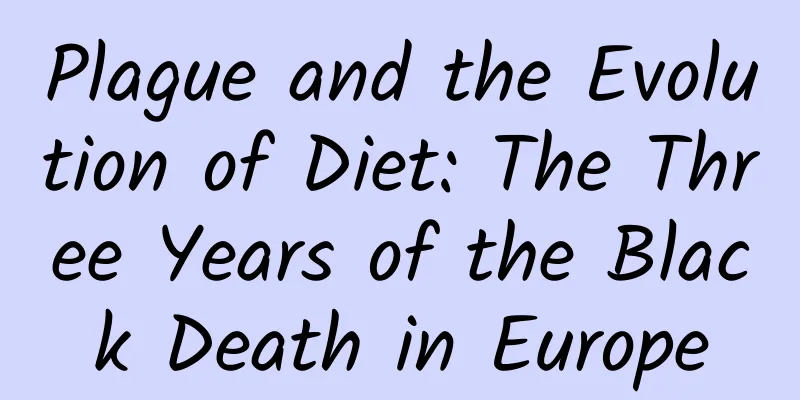Plague and the Evolution of Diet: The Three Years of the Black Death in Europe

|
Written by | Wei Shuihua Header Image | foodiesfeed No.1 For a long period of history, most people could not freely choose the food they liked. The level of civilization and material resources are the determinants of dietary structure. In ancient Greece and Rome, southern Europe and the Yellow River Basin in East Asia had the same production model of fishing, hunting and animal husbandry supplemented by farming. Therefore, the dietary habits of Europe before the Middle Ages were actually very similar to those of contemporary China. For example, byproducts of fishing, hunting and animal husbandry, such as easy-to-raise pork, easy-to-catch wild geese, lampreys and carp, are important sources of animal protein for Europeans to improve their diets, which is almost the same as the ancient Chinese habit of eating meat to improve their diets during festivals. In order to preserve meat, Europeans also invented pickling and fermentation techniques. Like the Chinese, they have more opportunities to eat pickled meat than fresh meat: by comparing the techniques of salami and Chinese sausage, Iberian ham and Jinhua ham, we can find clues. In terms of grains, China has millet native to the Yellow River Basin and rice native to the Yangtze River Basin, which are ranked first among the five grains. Eating is the simplest and most basic diet. Europe is at a higher latitude, and wheat is more commonly grown. Wheat flour, fermentation and baking are the mainstream, but the bread at that time was definitely not the fluffy, refreshing and milky bread we eat today. The fermentation technology was not up to standard, and there were no luxurious eggs and milk added, not to mention various spices. It should be more similar to the naan in Central Asia and Xinjiang. Naan does mean bread in Persian. In short, before the Black Death, rich cheese, wine, beef and lamb chops, and various baked snacks were rare in Europe. The dietary structure of Europeans at that time was very similar to that of China today. But everything was broken by an accident called the "Battle of Caffa". ©Reconstruction of the city of Kaffa No.2 The city of Kaffa is located in today's Ukraine. At that time, it was the border between the Golden Horde, one of the four great khanates of Mongolia, and the Republic of Venice, and was also the core port city in the Black Sea region. The Golden Horde was established by Batu, the grandson of Genghis Khan and cousin of Kublai Khan, when he invaded North Asia and Eastern Europe. Inheriting the brutality and greed of their ancestors, the rulers of the Golden Horde never stopped plundering the surrounding wealthy areas. Unfortunately, Venice, which made a fortune by relying on maritime trade at that time, was one of the richest countries in Europe. In 1346, the Mongol army of the Golden Horde launched a massive attack on the city of Kaffa. When they failed to capture the city, they used catapults to throw the bodies of people who died of plague into the city. This was the earliest recorded case of germ warfare. Plague, a disease spread by rodents, originated in Central Asia. The history before the Golden Horde was unknown. It is likely related to the poor hygiene habits of the Mongols and their dietary characteristics of eating raw meat and drinking blood. However, in Central and North Asia, which is sparsely populated and has experienced the massacres of the Mongols, infectious diseases encountered their biggest enemy: isolation. Therefore, it can only be called a case, not an epidemic. However, throwing the bodies of plague patients into a busy port was completely different in nature. The soldiers and civilians in Kaffa found that people were showing the same symptoms as the bodies thrown in: a large number of black spots appeared on the skin, blood and thick juice oozing out, high fever and mental disorder, and died in pain within 48 hours of onset. Therefore, people called it the "Black Death". © Necrosis and hemorrhage at the end of the finger, gangrene The devout Catholics collapsed, believing that this was "divine punishment". Soon the city gates were lost, and the Mongols experienced a second round of looting and massacres. The most terrifying thing was that after seeing the "divine punishment", the Venetian merchants hurriedly took their gold and silver and fled back to mainland Italy. At that time, they did not know the medical term "incubation period". The terrifying Black Death spread throughout Europe. The wider the spread of the disease, the more it is related to the movement of population and the communication of the world: all epidemics are like this. No.3 Just like the Chinese people would panic when facing an epidemic and look for some rare and uneaten things, such as Shuanghuanglian and Banlangen, to deal with the emergency, Europe, where modern medicine had not yet been born, also had such a habit. In 1348, the Black Death passed through Sicily and Genoa and reached the capital of the Papal States at the time, which was also the central city of the entire Catholic region: Rome. This caused turmoil throughout Europe. ©15th century woodcut: A surgeon uses a lancet to cut open the lymph nodes under the armpit of a plague patient People began to look for ways to cure diseases, and came up with methods such as smearing lumps with feces, bathing with urine, and putting toads on the chest. At that time, the rarest and most difficult luxury item in Europe was cane sugar. This condiment invented by the Arabs has not been in Europe for a long time, and people's production technology is not yet mature. In addition, sugar cane is needed to produce cane sugar, and there are few areas suitable for planting in Europe with higher latitudes. For ordinary people, even without theoretical support, cane sugar can be used to treat diseases because it is so white, sweet and expensive. For this reason, medical scientists traced back to Arab medical theories to provide evidence. At that time, the Salerno Medical School, an Italian medical center, wrote in a medical book: "Sucrose is effective for fever, cough, chest tightness, chapped lips, and stomach problems." In the face of the terrible Black Death, a life-saving straw finally appeared. Europeans hoarded sugar like crazy and added it to various foods, eating them in fancy ways. Later, in Italian, when people were in a desperate situation, they would say this idiom: "It's like a pharmacy without sugar." Today, in Europe, you can eat all kinds of sweet macarons, muffins, almond candies and puddings that are so sweet that they make you sick. In fact, they are all changes in eating habits driven by the Black Death. For Europeans, it also includes the meaning of "health preservation", which is the same as many Chinese people eating snake gall, dog whip, and bats. Even after the birth of modern medicine, this dietary habit still exists. The "low-sugar diet" that Europe and the United States are trying to promote today is essentially a conflict with the nation's dietary habits. No.4 In 1349, the Black Death spread to London via Paris. England and France, which were experiencing the Hundred Years' War, had to temporarily cease fire because of the brutal epidemic. However, the Kingdom of Scotland, England's arch-enemy in the north, set its sights on England, which was weak under the shadow of the Black Death. They invaded in large numbers, intending to "kill all the English who were punished by God in one go." The Scottish dream did not last long before England struck back, and because of the invasion, the Scottish soldiers were also infected with the Black Death virus. What the Scots didn’t know was that the epidemic, which had been spreading for more than two years, had been brought under control in a small part of England. King Philip VI of France died of the Black Death, but King Edward III of England and most of the royal family survived. Obviously, people at the time did not understand the iterative reduction effect of the toxicity of infectious viruses. People began to believe that the British royal family’s habit of eating less, more meals, and advocating afternoon tea was good for their health; while the French royal family, who loved gourmet food, pursued high-fat meat, which was not good for disease prevention. In fact, contemporary Chinese nobles also ate multiple meals a day, not for health, but because there was too much food to eat. Many people believe that this is the beginning of human civilization eating three meals a day plus afternoon tea. Five hundred years later, when the powerful ships and guns of the West opened the door to the East, Japan during the Meiji Restoration and China during the Beiyang Movement also abandoned the habit of eating two meals a day and began to eat three meals a day for all people. © Beijing News, Meiji Restoration 150th Anniversary "Eye-to-Eye" Weekly At the same time, the Western dietary concept of eating more vegetables and taking low oil, low fat and high fiber as the standard of healthy diet also began to change from this time. Today, Europeans and Americans often eat fresh vegetables and even add a piece of lettuce to high-calorie hamburgers. This is related to the "habit" of Europeans and Americans. No.5 Wu At the end of 1349 and the beginning of 1350, the Black Death bypassed the Scandinavian Peninsula and spread to the end of Eastern Europe: northern Russia. The whole of Europe fell completely. By that year, 25 million people had died from it. The large number of people who died in the agricultural era meant that a large amount of arable land became wasteland. Many women and children were forced to work, and social materials were extremely scarce. Prices began to soar, and labor wages also rose sharply. Many feudal lords went bankrupt because they could not afford to hire laborers. They were forced to rent out land and let the laborers cultivate it on their own. They also significantly reduced rent and taxes and required only fixed monetary rents. Against this backdrop, vast tracts of arable land were converted to pastures that required less labor: those who survived were in an advantageous position to produce more feed for livestock rather than grain for human consumption. As a result, meat, milk, and eggs became popular among the common people and were no longer exclusive to the nobility. It was from the Black Death that the protein intake of Europeans began to significantly surpass that of the East, where cereals were the staple food. This had an impact on the growth of physique and perhaps the evolution of intelligence. ©Tuscany, Italy, large tracts of fertile land used for pasture and grape cultivation Today, when you go to Europe, you can see all kinds of cheese and meat products on supermarket counters, which makes Oriental people often wonder if they are "eating cheese as a meal." In fact, this is directly related to the prosperity of animal husbandry and the oversupply of dairy products. At the same time, grapes, a plant native to West Asia that is drought-resistant and does not require much manpower to cultivate, were also planted in large quantities. This turned wine, which was originally used mainly as a religious ritual product, into a daily drink for ordinary people. The wine culture in Europe and the United States, which is known for its long history, only truly became mainstream at this time. In fact, if the process of Europe at that time was the same as that of Chinese history, repeatedly experiencing the process of war, disaster and reconstruction, perhaps decades after the Black Death, the agricultural population would overflow again and return to a society dominated by grain. But fortunately, decades later, the Age of Exploration arrived. No.6 Lu It was also during the period of 1349 to 1350 that the Black Death spread to Spain at the end of Western Europe. One-third of the population of Europe died as a result. Boccaccio described the tragic situation at the time in The Decameron: "Every day, even every hour, large numbers of corpses were transported to churches throughout the city. The church cemeteries could no longer accommodate them. Especially for some families, according to custom, they required burial in ancestral tombs, which made the situation even worse. When the cemeteries were full, they had to dig long and wide deep pits around them to bury hundreds of corpses that came later. Like cargo piled up in a ship's hold, these corpses were stacked in the pits, covered with only a thin layer of soil, until the entire pit was filled, and then sealed with soil." © Illustration from The Decameron The faith that Europeans had relied on for thousands of years collapsed. The churches that were supposed to save the world and save the people could not even bury the dead, and the clergy who usually wore holy light on their heads also fell ill one after another. People began to reflect on how God could save people. The Renaissance movement was born under the guiding ideology of criticizing the Pope and regaining the glory of the ancient Greek and Roman philosophers. This put the clergy under great pressure - the population was already decreasing, and many people gave up their faith, so preaching, going to farther and wider places to preach, became a rigid need. At the same time, the role of oriental spices in fumigating closed environments and disinfection was highlighted. The mysterious oriental paradise described by Marco Polo, "full of gold and tons of spices", has become an area that more and more Europeans have to explore. But at that time, the powerful and seemingly invincible Arabs and Mongols occupied the road to the East from Europe. The sea became the only hope for Europeans to go to the East. © Medieval plague doctor's attire: iron mouth loaded with herbs to purify the air One hundred years after the Black Death had subsided, a man named Columbus was born in Genoa, Italy, where the epidemic was the most severe that year. When he grew up, he sailed from Spain and finally arrived in a place called America. Peanuts, corn, and sunflowers, which originated in America, are the most widely planted oil crops. They have fundamentally changed the situation of high animal fat costs and low production of vegetable fats in the Old World, such as soybeans, rapeseed, and sesame. Europeans and Americans can fry chicken without restraint, and Chinese can stir-fry shredded pork with ease, all thanks to the sharp drop in the cost of vegetable oil. Potatoes and sweet potatoes, which originated in America, are staple foods with the highest yield per mu, far surpassing plant seeds such as rice and wheat. The great population growth during the Kangxi and Qianlong periods in China was closely related to their introduction. Chili peppers, which originated in the Americas, opened up a new era of condiments. They spread to East Africa and India via Europe, and then to Sichuan and Yunnan in China via Thailand, greatly changing the taste and eating habits of southwest China, and eventually becoming one of the basic colors of Chinese cuisine. In the final analysis, the great voyages of discovery, which were the opportunity for the development of food, had a cause-and-effect relationship with the Black Death that cannot be ignored. -END- Plague is a disaster that has coexisted with the entire human history, but from another perspective, it is actually a driving force for the progress of human culture. Faced with bacteria and viruses that are updated from generation to generation, human cognition is of course limited. After the plague, syphilis and smallpox will appear, and after defeating syphilis and smallpox, there will be AIDS and coronavirus. But their positive effects on society can be seen from past history. Those who are self-contained and proud of their ancestors' treasures will eventually be eliminated by the times; and embracing the social structure and value iteration brought about by the plague is the ladder for the growth of a country and a nation. |
<<: Recognize noise with a discerning eye and draw it!
Recommend
On World Telecommunication Day, let’s talk about why the disruptive technology quantum communication can achieve “absolute confidentiality”
Today is the 55th World Telecommunication Day. In...
Nightmares may be a sign of illness! If you have these symptoms, you must pay attention to them...
Expert of this article: Xue Shimin, deputy chief ...
Founder of WeChat Companion: How did a startup app with no money reach 400,000 users in 50 days with zero cost?
My name is SuRe. I’m an experienced product perso...
User Growth: Why isn’t your user base growing?
The changes of the times and channels will bring ...
15 years after the Wenchuan earthquake: They are more "insidious" than earthquakes, and this difficult problem has not been solved
We often lament the instantaneous power and destr...
The Avita 11 Hongmeng cockpit has been updated for the entire series. What are the differences after the upgrade?
In one month, the Hongmeng version of Avita 11 wa...
How to do marketing on Women’s Day? Here are 4 tips for you!
Today is International Women's Day... NO, you...
BeiDou-1, -2 and -3, what are they talking about?
If Beidou is still just a noun in your eyes After...
ARM's A77 chip may help Android phones surpass iPhones in 2020
According to foreign media reports, ARM has recen...
【Photo Editing】Photo Editing Class
【Photo Editing】A brief introduction to the resour...
In July, Tesla surpassed BYD and BAIC Motor topped the global electric vehicle sales chart
According to global electric vehicle sales data r...
Nexus 5 is being played with a new trick: somatosensory equipment
At this year's Google I/O conference, new prod...
Momo and Tantan: The secret behind a 60% monthly user retention rate
When it comes to domestic stranger social softwar...
Behind the five daily limit increases of Baofeng Technology: Which funds are "going against the wind"?
Baofeng Technology (300431.SZ), which was labeled...
Xu Jiaxi from Unicorn Think Tank: In-depth report on the ventilator industry
Source: Unicorn Think Tank Source: Industrial Sec...









